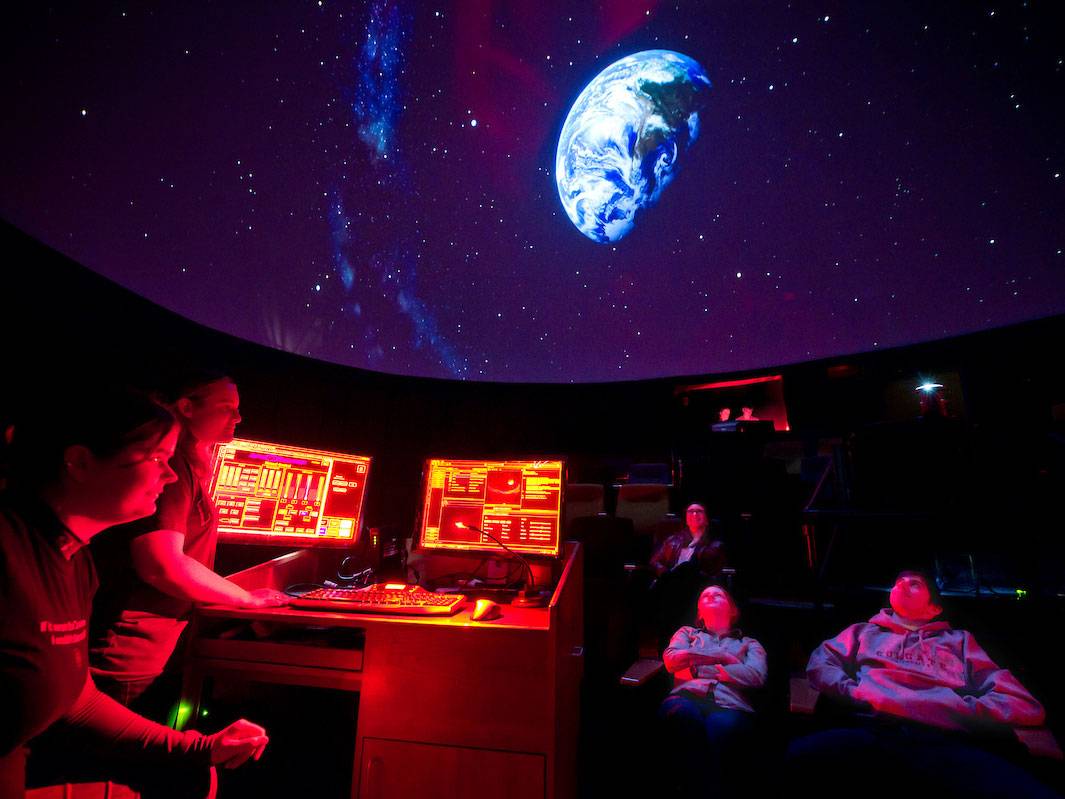This fall, the Ho Tung Visualization Lab hosted a lecture series titled “Interstellar Collaborations: Bridging Disciplines in the Fulldome Planetarium.” Taking place Sept. 21–Oct. 12, these sessions explored the interdisciplinary versatility of the Ho Tung VisLab and other fulldome planetariums to teach and entertain students.
The inspiration for the lecture series stemmed from a collaborative effort between Joe Eakin, the technical director and designer of the VisLab, and Cora Braun, a visiting PhD student from Kiel University of Applied Science in Germany, whose research focuses on the utilization of planetariums in the United States.
“We wanted to showcase how planetariums are being used here and at other sites,” explained Eakin. “No longer are they being used for just stars.”
The series opened with Braun’s lecture, “The Planetarium – Dispositifs through the ages,” which delved into her thesis research on the changing landscape of planetariums throughout the past century and how the arrangement of architectural elements within the planetarium can influence the audience’s experience.
“Thanks to the introduction of other forms of immersive media over the decades, the essence of what a planetarium is has changed a lot,” explained Braun. “I am trying to capture these different types and uses of planetariums within empirical research.”
During her six-week stay at Colgate, Braun has gained valuable insight into the functionality of tilted, unidirectional planetariums like the VisLab. “My home planetarium, the Mediendom, has a different theater layout,” explained Braun. “I wanted to get a better understanding of other layouts, and my stay at VisLab has definitely enabled me to do this.”
Braun also highlighted the interdisciplinary nature of Colgate’s VisLab, where collaborations extend across various academic disciplines. “The VisLab is known in the planetarium world for conducting many collaborations with a wide variety of disciplines within the university context,” said Braun. “This insight into the interdisciplinary use of the dome not only inspires my research, but is also something I can potentially transfer to my home planetarium in Kiel.”
One unique aspect of hosting these events in the VisLab is the experience it offers to the audience.
“The dome offers an immersive environment for viewers and lets them experience the universe in ways not possible with a flat screen,” Eakin said.
The series showcased interactive, immersive content produced not only at the VisLab but also by Braun’s fellow Kiel University students for their own Mediendom in Germany. These projects ranged from real-time simulations to film and theater productions, interactive gaming applications, and perception research.
“A planetarium dome is equipped with powerful digital tools and can be used in almost any area of teaching and research,” explained Braun. “It is a rather rare resource, especially at universities, but it has a great impact on student learning.”
September 21: An Introduction to the PhD Project
Braun introduced her PhD project, which explored the changing nature of planetariums over time. Her research systematically categorizes planetariums as dispositives using empirical methods, shedding light on their diverse types and uses. This research has broader implications for content production, facility planning, and the future development of planetariums.
September 28: Presentation of Student Fulldome Projects from Kiel University
Students from Kiel University presented a range of multimedia projects implemented in the Mediendom. These projects encompassed interactive fulldome games, music visualizations, theater plays, 3D audio, radio plays, and media reception research.
October 5: Multidisciplinary Uses of the Dome in the Ho Tung Visualization Lab
Eakin and Ahmad Khazaee, director of creative technologies, engagement, and support, discussed the multidisciplinary uses of the Ho Tung Visualization Lab’s dome at Colgate University. They highlighted the collaborations and interdisciplinary endeavors fostered by the planetarium during the last 15 years.
October 12: Using the Dome From the Perspective of Media Studies
Braun delved into the integration of the planetarium with the media studies program curriculum at Kiel University. Her presentation showcased the hands-on projects conducted by students through this program as well as theoretical future classes that could be offered exploring the history of immersive media.
The VisLab is open to the public on Friday evenings at 6:30, with free admission.
